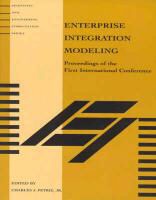Share
Fr. 85.00
Charles J. Petrie, Charles J. Petrie
Enterprise Integration Modeling - Proceedings of the First International Conference
English · Paperback / Softback
Shipping usually within 1 to 3 weeks (not available at short notice)
Description
The goal of enterprise integration is the development of computer-based tools that facilitate coordination of work and information flow across organizational boundaries. These proceedings, the first on EI modeling technologies, provide a synthesis of the technical issues involved; describe the various approaches and where they overlap, complement, or conflict with each other; and identify problems and gaps in the current technologies that point to new research.The leading edge of a movement that began with computer-aided design/computer-aided manufacturing (CAD/CAM), EI now seeks to engage the development of computer-based tools to control not only manufacturing but the allied areas of materials supply, accounting, and inventory control. EI technology is pushing forward research in areas such as distributed AI, concurrent engineering, task coordination, human-computer interaction, and distributed planning and scheduling. These proceedings provide the first common technical ground for comparing, evaluating, or coordinating these efforts.Charles J. Petrie, Jr., is Senior Member of Technical Staff at MCC in Austin, Texas.Topics include: Computer Integrated Manufacturing. Open System Architecture Standards. The results of five workshops on EI modeling topics: Model Integration, Model/Application Namespace, Heterogeneous Execution Environments, Metrics and Methodologies, and Coordination Process Models.
List of contents
Part 1 Group reports: the notion of a model; the integration domain and the enterprise characterization; the process of modeling and model integration; the model/application link; the integration domain and the application architecture; the integration domain and the execution environment; characterizing the need for enterprise integration; execution environment framework integration; metrics and models; modeling methodology; enterprise metrics - evaluation of investments towards integration. Part 2 General issues: dimensions of enterprise integration, H.T. Goranson; the suppliers' working group enterprise integration reference taxonomy, H.T. Goranson; representation, information flow and model integration, Christopher Menzel, et al; applications of logicist knowledge representation to enterprise modelling, Benhamin N. Grosof and Leora Morgenstern; a logic-based approach to enterprise integration, John F. Sowa and John A. Zachman. Part 3 CIMOSA: the CIMOSA approach as an enterprise integration strategy, H.T. Goranson; CIMOSA - a European development for enterprise integration part 1 - an overview, K. Kosanke, part 2 - enterprise modelling, Francois B. Vernadat, part 3 enterprise integrating infrastructure, B. Querenet; an overview of formal semantics specification methods, D. Zoetekouw. Part 4 Master models: process-based definition of enterprise models, Roger Burkhart; UNISON - a tool for enterprise integration, M.C. Bonney, et al; an object oriented method for integrated enterprise modeling as a basis for enterprise co-ordination, K. Mertins, et al; the FOF modelling framework - towards an integrated model for the design of production systems, Robert Kwikkers and John C. Wortmann. Part 5 Semantic unification: requirements for the development of layered information models, Wim Gielingh; enterprise integration using the semantic unification meta-model, James A. Fulton; enterprise information modelling and model integration in carnot, Michael N. Huhns, et al; model driven enterprise information management in carnot, Darrell Woelk, et al; the TOVE project - towards a common-sense model of the enterprise, Mark S. Fox; reference models for enterprise-wide data engineering, Alexander Hars and August-Wilhelm Scheer; the AIMS project - an information server architecture integrating data, knowledge and multimedia information, Maria Damiani, et al. Part 6 Federation: services in the SIRIUS-BETA inter-integration domain, H.T. Goranson; enterprise integration - lessons from SHADE and PACT, J M. Tenebaum, et al. Part 7 Co-ordination approaches: HITOP-A - co-ordination, infrastructure and enterprise integration, Les Gasser and Ann Majehrzak; an approach to modelling environment and task characteristics for co-ordination, Keith S. Decker, et al; capability based modelling, Christoph Bussler; task co-ordination in concurrent engineering, James Bowen and Dennis Bahler; a minimalist model for co-ordination, Charles Petrie. (Part contents)
Product details
| Authors | Charles J. Petrie |
| Assisted by | Charles J. Petrie (Editor) |
| Publisher | The MIT Press |
| Languages | English |
| Product format | Paperback / Softback |
| Released | 03.12.1992 |
| EAN | 9780262660808 |
| ISBN | 978-0-262-66080-8 |
| No. of pages | 581 |
| Series |
Scientific and Engineering Computation Scientific and Engineering Com |
| Subjects |
Natural sciences, medicine, IT, technology
> IT, data processing
> General, dictionaries
Social sciences, law, business > Business > Management |
Customer reviews
No reviews have been written for this item yet. Write the first review and be helpful to other users when they decide on a purchase.
Write a review
Thumbs up or thumbs down? Write your own review.

